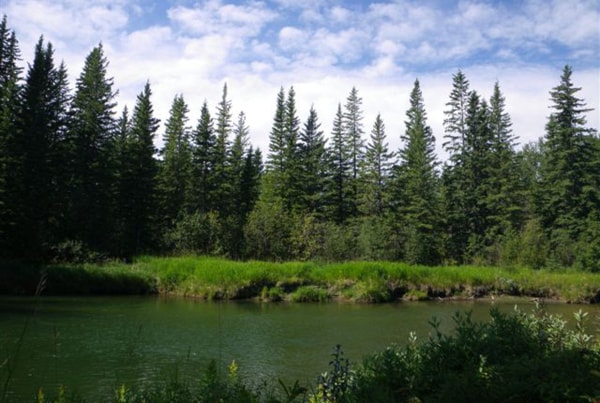Double-take: Blowing snow on a sunny, late-August mid-morning? But no, the roiling, sparkling flakes above the tail of a long pool were the first clouds of Trico spinners I had seen this season, indicating the hatch of our latest and smallest mayfly was “on.”
As usual on many waters the past few seasons, the trout were paying no attention whatever, certainly not gulping the spent Trico spinners by the mouthfuls as they do in some years. But the dragon flies — both the blue darners and the slightly smaller red skimmers — were darting back and forth through the cloud, eating Tricos as though they were mere mosquitoes.
If winter was not yet here, then surely autumn was upon us, so we went hunting in Central Alberta for signs of the great fall fishing I had been hearing about from Southern and Northern Alberta. We would conduct the usual fall hunt along favourite high, long, and under-cut grassy banks for signs of sneaky rises, indicating that big brown trout are “on” ants, or the occasional explosion indicating a grasshopper has misjudged its windage and become a mighty mouthful of trout protein.
We might find the signs, but fishing would be difficult. The best stream stretches for this are canal-like, deep and slow, with high banks both sides. You have to get within a cast of the far bank, but many anglers have been complaining that many Central Alberta streams are still too high, after a “summer” of rain, for safe or even effective wading.
Binoculars are essential in fall trout hunting. But, peer though I might, I found only one pod of small trout rising splashily to something, but they were protected, not only by trees on a high bank and deep water, but also by boot-sucking “quick-silt” that can have a wading angler in serious trouble sinking below the ultimate high water mark.
Then I remembered those dragon flies, and we decided to specialize, staking out known lairs of “dragon-eaters,” the laughter-inducing clown princes of usually dignified big brown trout, that specialize, around this time of year, in trying to catch, knock down, or off, low-flying dragon flies flitting up and down grassy stream banks.
I first encountered dragon eaters back when Cow Lake was a trophy trout fishery. The huge, jet-propelled, carnivorous dragon fly nymphs were on the move, and we were doing well with nymph imitations. New adults were hatching by the thousands and occasionally there’d be a big swirl under, or behind a low-flier. I cast a big grasshopper imitation at one of these swirls and was rewarded with a very large rainbow.
Since then, over the years, I have occasionally found what I consider to be the rarest of fly fishing’s many treats, dragon-eaters, while fishing hopper, ant, and even beetle patterns in the late summer and early fall. Although I have found rare rainbow examples along the Crowsnest River, the most frequent occurrences are along Central Alberta brown trout streams.
Finding favoured dragon-eater lairs is made easier when you spot the decidedly non-subtle “rise” of a dragon-eater, generally very large brown trout that leap totally out of the water to catch or, far more often, slap down a dragon fly.
For some reason, indentations and small beaches caused by bank slumping are places to watch. Two or three times over the years, I have seen big dragon-eaters ground themselves on the bank or those little beaches, and have to wriggle their way back into the water.
Sometimes the big brown is under the branches of a blow down, but the technique is the same as if he is in the clear: slap a really big fly (I used to use #6 Le Tort Hoppers) as soon and as close as you can to the dragon-eater and he’ll generally charge and eat it.
This is very entertaining and very rare fly fishing. The only reference even to the possibility of dry dragon fly fishing in my library is from The Complete Book of Western Hatches by Rick Hafele and Dave Hughes. After noting that the dragon fly nymph stage is most important to anglers, the authors say this: “We have seen trout go after low-flying adults, forming “V’s” and cutting bold wakes across the calm surface of lakes. We have heard of, but not seen, successful takes. There is enough evidence, however, to indicate adult patterns would be useful in many situations.”
So, in the absence of any recipes to guide me, I tied some huge adult blue darner imitations of my own, using lots of blue poly yarn and foam, white deer hair and grizzly saddle hackle, flies so ungainly that they actually buzzed as I cast them.
No matter, the weird dragon-eaters came out to meet and eat my weird dragon fly imitations, especially when I cast them down and across to the “lair” and dragged and gurgled them back upstream.
Bob Scammell is an award-winning outdoors writer living in Red Deer.
